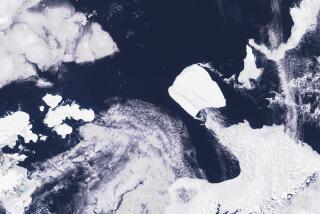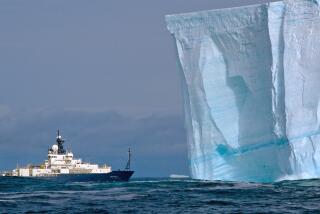Freeze frame in Alaska: Tracking Bering Glacier : The Delaware-sized ice chunk isn’t melting away, as scientists predicted. It’s moving briskly--for a glacier.
- Share via
FAIRBANKS, Alaska — From satellite images received here, from remote cameras on the seashore and from the periodic reports of bush pilots, scientists are following what for them is the event of a lifetime: a rampaging glacier as big as Delaware.
Just a year ago, there was a flurry of news accounts about the retreat of the Bering Glacier, the largest in Alaska and probably the largest temperate glacier in the world. It was melting faster than ice was advancing, and scientists said the process might have gone on so long that it was irreversible.
Eventually, they said, the retreating ice could leave a giant new fiord on the southern Alaska coast, 75 miles east of Cordova, or 360 miles southeast of Fairbanks.
Wrong.
Last spring, this huge river of ice--2,000 miles square with a mean thickness of 2,100 feet--began to stir.
The great accumulations of dense, frozen snow at the head of the glacier, triggered by a process that scientists do not wholly understand, began to bear down on the tongue of ice below. Water pressure built up underneath the entire sheet, providing a slick, lubricated surface.
Suddenly the mass began to rumble, crack, buckle and slide forward.
The technical word is surge.
And when a glacier the size of the Bering surges, all the cliches about poking along at glacial speed can be tossed out the window.
On some days now, this mass of ice is advancing toward the Gulf of Alaska at 300 feet a day, displacing much of the tidewater lake that was once at its base. As it moves forward, the bulging ice tends to shatter into huge rectangular ice towers called seracs.
Imagine what Mt. St. Helen’s meant to volcanologists. Or the “Big One” to seismologists. Glaciologists view this surge as comparable.
“This thing is fairly smoking along. It’s a career event. There isn’t going to be anything like this probably for the rest of our careers,” said Dennis Trabant, a glaciologist for the U.S. Geologic Survey in Fairbanks.
The trouble is, the Bering Glacier is in a remote area with violent weather. So this winter almost no one--except passing bush pilots--is able to witness the event firsthand.
One pilot, Gail Rainey of Cordova, called the scene “fantastic,” although in truth, movement of the ice is so incremental that it cannot quite be perceived by humans on the ground--sort of like trying to watch the hour hand move on a clock.
Trabant arranged a time-lapse camera in front of the advancing ice. That worked fine--showing the mighty buildup of the face of the glacier and the epic cracks that developed along its tongue as it shouldered forward--until a hungry brown bear vandalized the camera.
So now most of the watching is done at the Geophysical Institute at the University of Alaska, Fairbanks. A European satellite passes over the vicinity periodically, and scientists employ a technology known as synthetic aperture radar imagery, or SAR, to produce detailed pictures of the entire mass of the glacier.
On a computer screen, the images can be displayed sequentially, like a short movie, to reveal a process never before seen--a squirming river of ice 120 miles long and seven miles wide flowing down canyons of the Chugach-St. Elias Mountains.
So it’s an interesting and spectacular occurrence, but is it important?
It might be, said Craig S. Lingle, associate professor of research at the Geophysical Institute and director of the Bering Glacier radar-imaging project.
“It could be a laboratory, a microcosm for studying the largest ice sheets--those of Antarctica and Greenland,” he said. Those ice masses hold most of the world’s fresh water, and any change in their size or behavior would catastrophically alter the level of the oceans.
As it is, Lingle said, the oceans are now rising about 1.8 millimeters, or 0.07 inch, a year on the average. Over the last 100 years, sea level has crept up about seven inches.
“A significant percentage of that is thought to be associated with the melting of ice and glaciers in temperate latitudes, roughly one-third of which is due to melting of glaciers in Alaska and the Yukon,” he said.
By itself, the Bering is unlikely to shed light on global climatic change. But there is little doubt that during this surge, which could last two years or more, scientists will have their best crack yet at trying to decipher the mysteries of glacial ice on the march.
More to Read
Sign up for Essential California
The most important California stories and recommendations in your inbox every morning.
You may occasionally receive promotional content from the Los Angeles Times.













